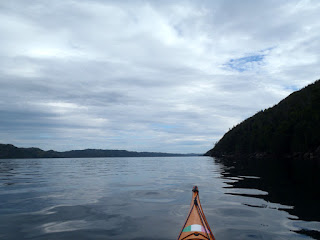We've had a mixed bag of weather in the previous 5 days of our Placentia Bay adventure. On day 6, Thursday, we woke to fog and a bit of wind. Dean remarked he didn't seep well on account of the wind. I, on the other hand, wasn't bothered at all. I had blueberry pancakes with the blueberries I picked the evening before though they would have tasted better under sunlight.
I looked out through the entrance to Sand Cove where the sea was bashing in quite good. I knew it was going to be a bumpy ride.
I lead the pack out through into the open ocean keeping a watchful eye on the submerged rocks at the entrance to Toslow and Sand Cove. The water really reared up breaking into a mass of white foam. It took a little while to find my rhythm in the 1 and 2 meter waves. I didn't stop to take many pictures out of fear of losing ground to the others intently paddling but I did feel the need for some. One resulted in just waves as Hazen disappeared behind a wall of water. This one doesn't show any breaking waves but at least I caught Hazen off to port as we passed White Sail Head.
At Eastern Head, an hour after leaving camp, we were at the end of the SW trending landmass. We rafted up inside the head to discuss the next objective. We settled on a 2.5 km crossing bypassing Great Bona Cove to ...
... make land again at Little Bona Cove. The water raised up as it entered the constricted bay.
Making landfall again at Little Bona Cove we were paddling SW again and two kilometers later we were at Little Paradise. I'm sure on a sunny day it is but in fog, not so much. We negotiated the narrow entrance safely as ...
... the harbour opened up. A few houses, a still serviceable wharf and fish plant are all that's left of the resettled community whose population peaked at 108 in 1935. Little Paradise was resettled in the 1960's but still had permanent residents living there as late s 2009.
Little Paradise has a larger harbour than the nearby, and soon to be visited, Great Paradise. The interesting thing about the name, in spite of the larger harbour, is that entrance to the harbour is made with "little" trouble. Entry to Great Paradise, on the other hand, was done with "great" difficulty. It had nothing to do with the size of the population.
We usually count on finding flat land to pitch our tents on when visiting resettled communities but that's not necessarily the case every time. This traditional looking house brightly painted pink is propped up by stilts on the rocky slope. Not sure about the amenities the house has but it does get satellite TV.
Leaving Little Paradise we made the short hop over to Great Paradise, Neville maybe jubilant we were out of the bigger water. The Gull Islands on the horizon which were in front of us for most of the morning receded with each paddle stroke.
Approaching Great Paradise we had Marticott Island on the left and Fox Island directly in front.
There were more buildings at Great Paradise but it too has been resettled. The houses that now serve as summer places looked well kept and they even a community center. Boats were tied up indicating people were there but no one was out and about so we went on.
Its a well protected harbour which no doubt was a major attraction to settlement. The census for 1836 shows a population of 66 and grew to 197 in 1921 but declined thereafter.
We said good-bye to Great Paradise without getting out of our kayaks, paddled across Red Cove, which looked more like a bay to me, and entered Paradise Sound. The Sound is a some 30 km long indentation of the sea where the still settled community of Southeast Bight is located near the entrance. Its isolated, the only access is by personal boat or by the provincial ferry service.
As we arrived people came out of their houses to chat and take pictures. The people of Southeast Bight are typical of outport Newfoundland. Friendly, salt of the earth people who would do anything for a stranger. Its well documented by kayakers who have circumnavigated the island that they were often welcomed into homes to clean up and share a meal. I'm sure we could have found lodging had we stayed but we were destined for further up the sound We got a weather forecast which was most helpful.
We continued on past Southeast Bight after our conversations. Ahead lay, what in my mind was, a monotonous paddle along an uninteresting shore. We were intent on reaching a campsite that was about 2 hours paddle from Monkstown where we would conclude our trip. We were informed of a campsite about 6 kms from the community. An hour later still no options in sight. I kept thinking how much longer could it be. Turns out ...
... the said campsite at Channels Harbour was 11 kms out.
In any case, it was a fine campsite, well protected but devoid of wood for our usual campfire. So, we had to consume our medicine entertained by the bioluminesence on the small wavelets rolling over a rock in front of us.
It was a long 8 hour, 35 km day which started in challenging conditions and ended with a good nights sleep, the last one in Placentia Bay for this year at least.
The track from Toslow/Sand Cove to Channels Harbour.



























































